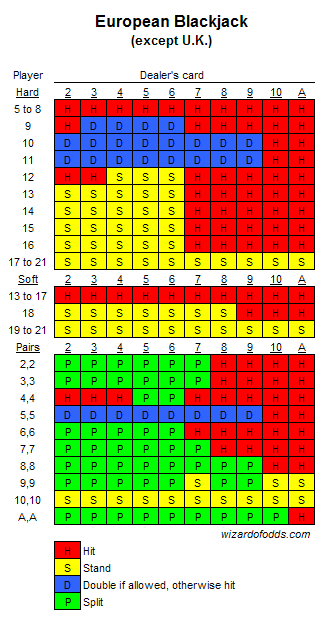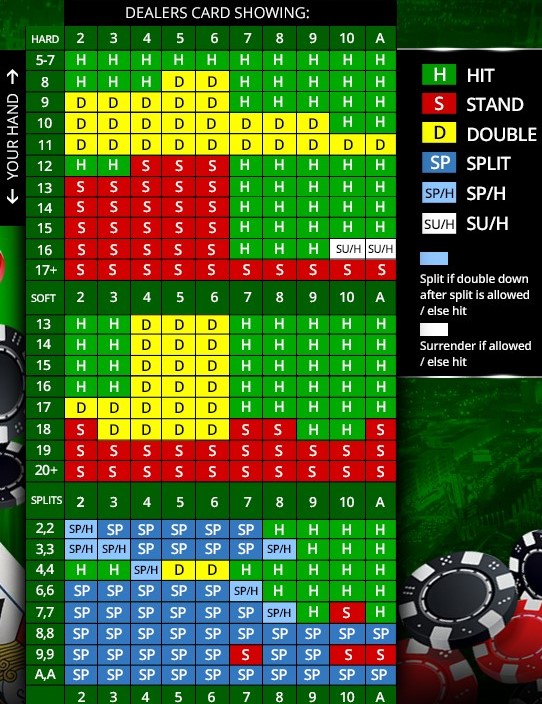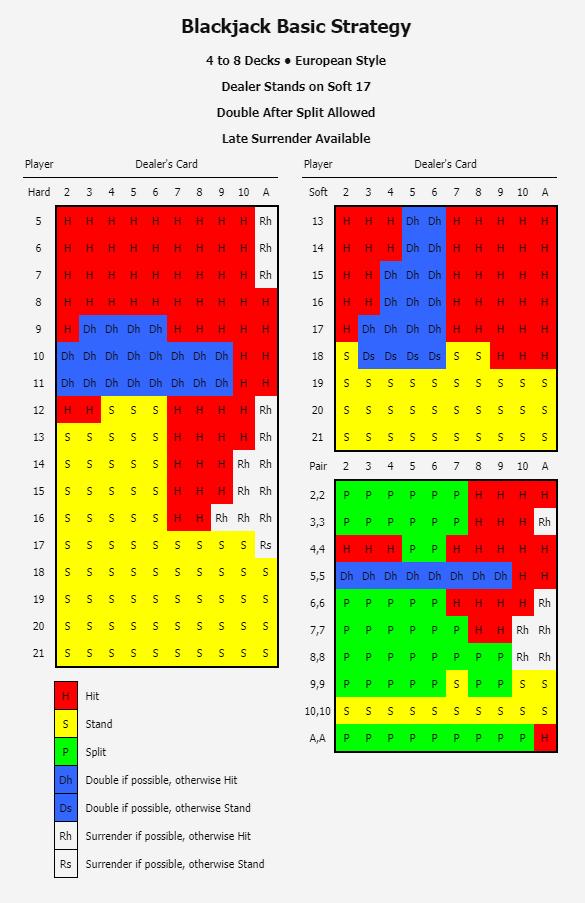Blackjack Surrender Strategy
Blackjack Surrender is a great option for those who are struck by bad luck. As the name suggests, players are given the option to surrender and lose the game, but also keep half of their bet amount. This option significantly reduces the house edge. The game is usually played with six decks of cards, as is in the case of Playtech’s spin on the variation on which we’re going to focus in this review. You can try this game for free a little bit further down this page or you can play Blackjack Surrender for real money at Ladbrokes:
| Blackjack Site | Rating | Highlights | Welcome Bonus | Trusted Site | Terms and Conditions |
|---|---|---|---|---|---|
| Ladbrokes Casino | Recommended Casino | £50 Bonus | Play here! | Full T&Cs apply. 18+. New Casino players only. Deposit required. Min stake £10 on qualifying games. 40x wager reqs (bonus only) on selected games. 24hrs to accept. Bonus valid for 48hrs. Certain deposit types excluded. Bets covering >70% of Roulette table excluded. |
Blackjack Surrender allows the dealer to peek for blackjack; however, the dealer stands when receiving a soft 17. This is an interesting blackjack variation, with a relatively low house edge, which gives the players an opportunity to save themselves after being dealt a really bad hand. Check out the rest of the page for more details about the game.
The strategy of blackjack surrender depends on whether the dealer hits or stands on soft 17. There are only four instances when a player should surrender when the dealer stands on soft 17. There are seven times a player should surrender when the dealer hits a soft 17. For the non-card counter, even the perfect basic strategy player, surrender has very little to offer, less than one tenth of 1% for perfect surrender decisions. Interpolating from Peter Griffin's Theory of Blackjack, the basic strategy value of surrender goes up as more decks are added. Rounded to the nearest hundredth of a percent, these are. Blackjack should need no introduction. It is the most popular table game in the United States, and is easily found in casinos throughout the world. The object of the game of Blackjack is simply to get more points than the dealer without going over 21. Rules Hand Signals Wizard’s Simple Strategy Basic Strategy Blackjack FAQ.
Blackjack Surrender Free Play
As in any other casino game, it’s recommended that you try Blackjack Surrender in free play mode before you bet your own money on it. You can try the demo game below and decide for yourself whether it’s the right variation for you:
How to Play – The Rules of the Game

Depending on the game developer certain rule modifications can be found when playing Blackjack Surrender. First of all, the regular rules for playing blackjack apply to this variation, unless there are highlighted exceptions. The game is usually played with six decks of cards and the dealer stands on soft 17. The player can double on the first two cards, as well as double after splitting. However, splitting is allowed only once.
The table setting is similar to all the other blackjack games. The dealer first deals two cards to himself and to the player. This is when the player has the opportunity to place a side bet in case the dealer holds an Ace; the dealer is always allowed to peek for blackjack. Additionally, the player can choose to hit, stand, split or double. Of course, if the player has a very bad combination of cards he can take advantage of the surrender rule and give up his cards alongside with half of the initial bet amount.
If the player is dealt a pair of cards, he may split them once. However, the player cannot resplit nor hit split Aces. If the dealer or the player goes over 21 they bust and lose the game. Same as all blackjack games’ objective, in order to win, the player should beat the dealer’s hand by hitting a blackjack or having a bigger amount than the dealer.
Odds and House Edge
The house edge of Blackjack Surrender depends on the number of deck with which the game is played and certain rule variations, such as whether the dealer hits or stands on soft 17 and if player can or cannot resplit Aces. For example, in a Blackjack game played with six decks, where the dealer stands on soft 17, the player can resplit for four hands and resplit the Aces, the house has an edge of 0.25%. In contrast, when everything is the same, yet the player is not allowed to resplit, the house edge increases to 0.39%.
Side Bets
As is commonly known, side bets are seen as unprofitable bets since they increase the house edge. However, in this game players are given the chance to place insurance bets whose pay out is 2:1. In this particular game, the insurance bet can be placed only on a dealer Ace. After the dealer has received a face up Ace, the player is offered insurance bet half the amount of the regular bet. In case of a dealer blackjack, the player loses his full bet; however, since the side bet pays 2:1, the player wins as much as he lost.
Blackjack Surrender strategy
The best strategy for playing Blackjack Surrender with a house edge of 0.38%, 6 decks and a dealer who stands at soft 17 is to know all of your possibilities and know when to surrender. Surrendering is advisable only when you hold a hard 16 and the dealer has 9, 10 or Ace. Another option to surrender is in case the dealer holds 10, while you have a hard 15. One you have read the strategy section, be sure and try to beat the dealers at William Hill Casino, where you can find this and other interesting variations of the game.
Hit any time you hold a hard 5-12 or soft 3-7, no matter the dealer’s card. An exception to this is a situation in which the dealer holds 4, 5 or 6 against your hard 12. If the dealer received 7, 8, 9, 10 and Ace, and the player holds hard 13-16, the best options is to hit. Exceptions are the surrender suggestions which were explained before. Pairs of 2-2, 3-3, 4-4, 6-6 and 7-7 should be kept if the dealer shows 8, 9, 10 and Ace. When it comes to pair of fours, the player should also hit when the dealer has 2, 3, 4 or 7.
The player is advised to stand whenever he has a hard hand of 17+, soft 9 or 10 and a pair of tens. Additionally, having in hand hard 12-16 when the dealer shows 2, 3, 4, 5 or 6 is another sign to stand. A 9-9 pair opposite the dealer’s 7, 10 or Ace should make the player to stand. Finally, the player has to stand on soft 18 if the dealer holds 2, 7 or 8.
Splitting eights, nines and aces is always a good idea unless stated differently in the text above. A 2-2 and 3-3 pairs is advisable to be split in situations when the dealer has 2, 3, 4, 5, 6 or 7. If the player gets 5-5 and the dealer has any card except 10 and Ace, the player should consider doubling the bet. The same applies for hard 10, 11 and soft 3, 4, 5, 6, 7 and 8 after the dealer shows 3, 4, 5, 6 or 7. There are some exceptions to this rule and they were already explained.
Good to Know About This Game
Definitely one of the best aspects of playing Blackjack Surrender is the possibility to save yourself and regain half of your wager. Depending on the rule modifications, this game can have low to medium house edge compared to other blackjack variations. The option to surrender makes this game favorable to the players and having a bad combination of cards not necessarily means losing the whole bet. Nevertheless, all the basic blackjack rules apply to this variation, hence the possibility to surrender is just one advantage plus for the player.
Does the concept of the surrender rule in blackjack confuse
you?
You’re not alone.
We think this is the least-understood rule in blackjack. The
difference between early surrender and late surrender is
important. Improving your understanding of blackjack surrender
rules means improving your overall game strategy.
Some blackjack games allow players the option of giving up
(or “surrendering”) their hands right after the initial deal is
complete, for the cost of half of their ante bet. The idea is to
quit while you’re ahead if you feel like you don’t have a shot
at winning the hand. Surrender rules are an advantage for the
player, in that she can choose to keep half of her original bet
rather than play out her hand and lose the entire thing.
Blackjack surrenders come in two flavors: early and late.
To use the surrender rule to your advantage, it’s important
to understand the differences between the two types of
surrender.
What Is Early Surrender?

An early surrender is when the player chooses to give up on
their hand immediately after the cards are dealt but before the
dealer checks for a natural blackjack. The early surrender
requires that players forfeit half their original wager.

The early surrender rule is the most desirable type of
surrender because it’s available regardless of whether or not
the dealer was dealt a natural. As is often the case with rules
that favor the player, the early surrender rule is rare these
days.
Why has the early surrender disappeared?
According to the Wizard of Odds, the addition of an early
surrender rules cuts into the casino’s built-in edge by 0.63%.
To put that in perspective, changing a game’s shoe from eight
decks to one affects the house edge less (+0.59%) than the
addition of an early surrender rule.
This doesn’t means that casinos won’t offer early surrender –
some do–especially online casinos.
But they compensate with other rule changes that chisel away
at the advantage you gain from the early surrender rule.
What Is Late Surrender?

The late surrender rule allows a player to give up on their
hand for the cost of half their ante, just like an early
surrender.
But unlike an early surrender, this rule requires that you
wait to see if the dealer has been dealt a natural blackjack
first. If the dealer did catch a natural, you can’t surrender,
and you’ll lose your whole wager just like if you never chose
the surrender option in the first place.
Blackjack Late Surrender Strategy
Late surrender rules don’t lower the casino’s edge anywhere
near the amount that early surrender rules do.
According to the same source at Wizard of Odds, a late
surrender rule cuts into the casino’s edge by about 0.1%–about
as much as a Doubling rule. As a consequence of its smaller
negative impact on the casino’s bottom line, you’re more likely
to see this form of the surrender rule than the early version.
Even though the reduction in the house edge is small, it’s an
advantage that’s worth seeking out.
Blackjack Strategy Surrender
A note on blackjack etiquette and surrender rules – it’s
common for land-based casinos to offer a late surrender without
advertising it. You should always ask your dealer if there’s a
late surrender option. Even though the player advantage is
small, the casino isn’t in the business of giving any amount of
money away.
The Difference Between Early & Late Surrender
The difference between the two is simple – early surrender
rules allow you to give up your hand for half your wager even if
the dealer holds a natural blackjack, while late surrender rules
allow you to give up half your wager only if the dealer doesn’t
hold a natural.
Surrender Strategy
The strategy for games with early surrender and games with
late surrender rules is different enough that even the ideal
playing styles are different. Here’s a basic guide to the proper
ways to play for both early and late surrender blackjack games.
When You Should Take an Early Surrender
Though the early surrender is a tempting move when you find a
table that offers it, we only recommend you consider abandoning
your wager in the following three situations:
- When the dealer shows Ace and you hold a hard total of 5 – 7 or 12 – 17.
- When the dealer shows Ace and you hold 33, 66, 77, or 88.
- When the dealer shows any 10 and you hold a hard total of 14-16.
You should hit on hard totals between 8 and 11, but up
against an Ace the early surrender rule gives you the best
possible return on pretty much every other hard hand.
These are all acceptable split hands in other situations but
against a soft dealer hand, an early surrender is the acceptable
play here.
If you draw is anything about 5-7, you’re bust. Unless you’re
keeping a stellar count, you’re in dangerous territory, and the
early surrender will help you cut your losses.
When You Should Take a Late Surrender
Once again, the late surrender option may be appealing in
plenty of game situations, but we only think it is
strategically-feasible in the following three:
- When the dealer shows Ace and you hold any total of 15.
- When the dealer shows Ace or any 10 and you hold any total of 16.
- When the dealer shows Ace and you hold any total of 17.
The only exception here is that you don’t surrender if the
game’s rules indicate that the dealer must hit a soft 17.
This rule is true regardless of the game’s rules regarding
how the dealer behaves on a total of 17.
If you’re playing in a game in which the dealer is forced to
hit a soft 17, ignore this rule.
When You Should Refuse a Late Surrender

Blackjack Surrender Strategy Chart
Here are a couple of common mistakes blackjack players make
with the late surrender rule:
- You should NOT take a late surrender when the dealer stands
on soft 17 while showing a 9, 10, or Ace while you hold any
total of 15 or 17. - You should NOT take a late surrender when the dealer shows a
9 and you hold any total of 16.
This is one of those rules you just have to memorize at first
until it starts to make sense to you at the table.
This is simple mathematics. The dealer is more likely to come
in underneath your point total than you are to bust out by
taking a hit.
Surrender In Blackjack Strategy
Anyone who’s played a round or two of blackjack in the casino
appreciates the appeal of the surrender rule. Sometimes it’s
best to accept the loss of half your ante and hope for a better
deal.
The most obvious example is 16, the worst garbage hand in the
game.
Holding a 16 looks even worse when the dealer is showing a
10.
Blackjack Basic Strategy No Surrender
This is just one example of a time when you’re obviously
better off giving up half the ante and moving past the terrible
deal. If you think of this move as getting back half of a bet
you would have lost, you see the beauty of the blackjack
surrender rule.